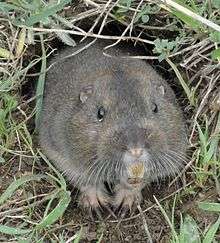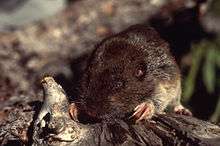Gopher
Pocket gophers, commonly referred to as just gophers, are burrowing rodents of the family Geomyidae.[2] There are about 35 species, all endemic to North and Central America.[3] They are commonly known for their extensive tunneling activities and their ability to destroy farms and gardens.
| Pocket gophers | |
|---|---|
 | |
| Botta's pocket gopher (Thomomys bottae) | |
| Scientific classification | |
| Kingdom: | Animalia |
| Phylum: | Chordata |
| Class: | Mammalia |
| Order: | Rodentia |
| Superfamily: | Geomyoidea |
| Family: | Geomyidae Bonaparte, 1845 |
| Genera | |
|
Cratogeomys | |
| Diversity | |
| Around 35 species in 6 genera | |
The name pocket gopher on its own may refer to any of a number of genera within the family Geomyidae. These are the "true" gophers, but several ground squirrels in the distantly related family Sciuridae are often called "gophers", as well. The origin of the word 'gopher' is uncertain; French gaufre, meaning 'waffle', has been suggested, on account of the gopher tunnels resembling the honeycomb-like pattern of holes in a waffle;[4] another suggestion is that the word is of Muskogean origin.[5]

Description
Gophers weigh around 200 grams (1⁄2 lb), and are about 15–20 cm (6–8 in) in body length, with a tail 2.5–5 cm (1–2 in) long. A few species reach weights approaching 1 kg (2.2 lb). Within any species, the males are larger than the females and can be nearly double their weight.[6]
Average lifespans are one to three years.[7] The maximum lifespan for the pocket gopher is about five years.[8] Some gophers, such as those in the genus Geomys, have lifespans that have been documented as up to seven years in the wild.[7]
Most gophers have brown fur that often closely matches the color of the soil in which they live. Their most characteristic features are their large cheek pouches, from which the word "pocket" in their name derives. These pouches are fur-lined, can be turned inside out, and extend from the side of the mouth well back onto the shoulders. Gophers have small eyes and a short, hairy tail, which they use to feel around tunnels when they walk backwards.
Pocket gophers have often been found to carry external parasites.[7] Common predators of the gopher include weasels, snakes, and hawks.[9]
Behavior
All pocket gophers create a network of tunnel systems that provide protection and a means of collecting food. They are larder hoarders, and their cheek pouches are used for transporting food back to their burrows. Gophers can collect large hoards. Unlike ground squirrels, gophers do not live in large communities and seldom find themselves above ground. Tunnel entrances can be identified by small piles of loose soil covering the opening.[10] Burrows are in many areas where the soil is softer and easily tunneled. Gophers often visit vegetable gardens, lawns, or farms, as gophers like moist soil (see Soil biomantle). This has led to their frequent treatment as pests.
Gophers eat plant roots, shrubs, and other vegetables such as carrots, lettuce, radishes, and any other vegetables with juice.[11] Some species are considered agricultural pests. The resulting destruction of plant life then leaves the area a stretch of denuded soil. At the same time, the soil disturbance created by turning it over can lead to the early establishment of ecological succession in communities of r-selected and other ruderal plant species. The stashing and subsequent decomposition of plant material in the gophers' larder can produce deep fertilization of the soil.
Pocket gophers are solitary outside of the breeding season, aggressively maintaining territories that vary in size depending on the resources available. Males and females may share some burrows and nesting chambers if their territories border each other, but in general, each pocket gopher inhabits its own individual tunnel system. Although they attempt to flee when threatened, they may attack other animals, including cats and humans, and can inflict serious bites with their long, sharp teeth.
Depending on the species and local conditions, pocket gophers may have a specific annual breeding season, or may breed repeatedly through the year. Each litter typically consists of two to five young, although this may be much higher in some species. The young are born blind and helpless, and are weaned around 40 days old.[12]
Control
Geomys and Thomomys species are classed as "prohibited new organisms" under New Zealand's Hazardous Substances and New Organisms Act 1996, preventing them from being imported into the country.[13]
Classification
Much debate exists among taxonomists about which races of pocket gophers should be recognized as full species, and the following list cannot be regarded as definitive.
_Weishuhn_Rd._Colorado_Co._TX%3B_12_May_2014.jpg)
- Family Geomyidae
- Genus Cratogeomys; some authors treat this genus as a subgenus of Pappogeomys.
- Yellow-faced pocket gopher (Cratogeomys castanops)
- Oriental Basin pocket gopher (C. fulvescens)
- Smoky pocket gopher (C. fumosus)
- Goldman's pocket gopher (C. goldmani)
- Merriam's pocket gopher (C. merriami)
- Genus Geomys – eastern pocket gophers; principally live in the southwestern United States, east of the Sierra Nevada mountains
- Desert pocket gopher (Geomys arenarius)
- Attwater's pocket gopher (G. attwateri)
- Baird's pocket gopher (G. breviceps)
- Plains pocket gopher (G. bursarius)
- Knox Jones's pocket gopher (G. knoxjonesi)
- Texas pocket gopher (G. personatus)
- Southeastern pocket gopher (G. pinetis)
- Central Texas pocket gopher (G. texensis)
- Tropical pocket gopher (G. tropicalis)
- Genus Orthogeomys – giant pocket gophers or taltuzas; live in Mexico, Central America, and Colombia
- Chiriqui pocket gopher (Orthogeomys cavator)
- Cherrie's pocket gopher (O. cherriei)
- Oaxacan pocket gopher (O. cuniculus)
- Darien pocket gopher (O. dariensis)
- Giant pocket gopher (O. grandis)
- Variable pocket gopher (O. heterodus)
- Hispid pocket gopher (O. hispidus)
- Big pocket gopher (O. lanius)
- Nicaraguan pocket gopher (O. matagalpae)
- Thaeler's pocket gopher (O. thaeleri)
- Underwood's pocket gopher (O. underwoodi)
- Genus Pappogeomys; live in Mexico
- Alcorn's pocket gopher (P. alcorni)
- Buller's pocket gopher (P. bulleri)
- Genus Thomomys – western pocket gophers; widely distributed in North America, extending into the northwestern US, Canada, and the southeastern US.
- Botta's pocket gopher (T. bottae)
- Camas pocket gopher (T. bulbivorus)
- Wyoming pocket gopher (T. clusius)
- Idaho pocket gopher (T. idahoensis)
- Mazama pocket gopher (T. mazama)
- Mountain pocket gopher (T. monticola)
- Northern pocket gopher (T. talpoides)
- Townsend's pocket gopher (T. townsendii)
- Southern pocket gopher (T. umbrinus)
- Genus Zygogeomys
- Michoacan pocket gopher (Zygogeomys trichopus)
- Genus Cratogeomys; some authors treat this genus as a subgenus of Pappogeomys.
Some sources also list a genus Hypogeomys, with one species, but this genus name is normally used for the Malagasy giant rat, which belongs to the family Nesomyidae.
In popular culture
- Minnesota is nicknamed the "Gopher State", and the University of Minnesota's athletics teams are collectively known as the Golden Gophers, led by mascot Goldy Gopher.
- Internet Gopher protocol was created at the University of Minnesota.
- Gainer the Gopher is the mascot of the Saskatchewan Roughriders in the Canadian Football League.[14]
- A gopher also plays a key role in the film Caddyshack.[15]
- The mascot of the Go programming language is the Go Gopher.[16]
- Gordon the Gopher is an English puppet gopher which appeared on Children's BBC (CBBC) between 1985 and 1987.[17][18]
- Gopher is a character in the Disney cartoon adaptations of the children's book Winnie-the-Pooh.
See also
- Naked mole rat
- Mole
References
- Eduardo Jiménez-Hidalgo; Rosalía Guerrero-Arenas; Krister T. Smith (2018). "Gregorymys veloxikua, The Oldest Pocket Gopher (Rodentia: Geomyidae), and The Early Diversification of Geomyoidea". Journal of Mammalian Evolution. 25 (3): 427–439. doi:10.1007/s10914-017-9383-z.
- "ODFW, Oregon Wildlife Species: Gophers". Dfw.state.or.us. 2014-08-25. Retrieved 2017-05-27.
- "Outwit Critters:". Retrieved 16 January 2014.
There are 35 species of gophers living in both North and Central America.
- "Archived copy". Archived from the original on 2017-04-04. Retrieved 2017-04-03.CS1 maint: archived copy as title (link)
- "American Heritage Dictionary Entry: gopher". Ahdictionary.com. Retrieved 2017-05-27.
- Macdonald, David W., ed. (2006). The Encyclopedia of Mammals. Oxford University Press. ISBN 0-19-920608-2.
- Hygnstrom, Scott E. (2010). Prevention and Control of Wildlife Damage. DIANE Publishing Inc. p. B–21. ISBN 1-4379-3688-1.
- Whisson, Delsey. Small Grain Production Pt 8: Pest Management -- Vertebrates. UCANR Publications. p. 5. ISBN 1-60107-411-5.
- "Pocket Gophers". National Wildlife Federation. Retrieved 19 January 2014.
- "Gopher". A-Z Animals. Retrieved 19 January 2014.
- "Pocket Gopher FAQs:". Retrieved 2 February 2018.
- Patton, James (1984). Macdonald, D. (ed.). The Encyclopedia of Mammals. New York: Facts on File. pp. 628–631. ISBN 0-87196-871-1.
- Hazardous Substances and New Organisms Act 2003 - Schedule 2 Prohibited new organisms, New Zealand Government, retrieved 26 January 2012
- "Archived copy". Archived from the original on 2012-11-09. Retrieved 2010-09-17.CS1 maint: archived copy as title (link)
- Martin, Scott (25 March 2007). "The Book of Caddyshack: Everything You Ever Wanted to Know About the Greatest Movie Ever Made". Taylor Trade Publishing – via Google Books.
- "The Go Gopher - The Go Blog".
- "Archive - The CBBC Broom Cupboard - 25 Years of live Children's BBC presentation". BBC. Retrieved 2017-05-27.
- TV, Guardian (6 August 2015). "Gordon's alive! Phillip Schofield's puppet sidekick is back". The Guardian.
External links
| Wikimedia Commons has media related to Geomyidae (Pocket gophers). |
- Article on the Animal Diversity Web site
- . Encyclopædia Britannica (11th ed.). 1911.
